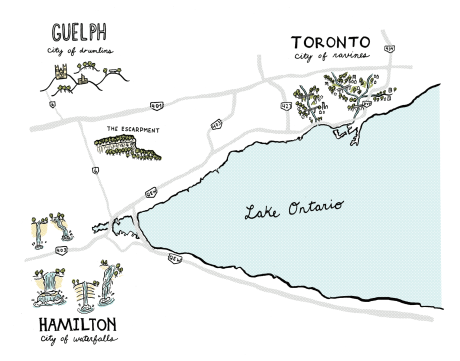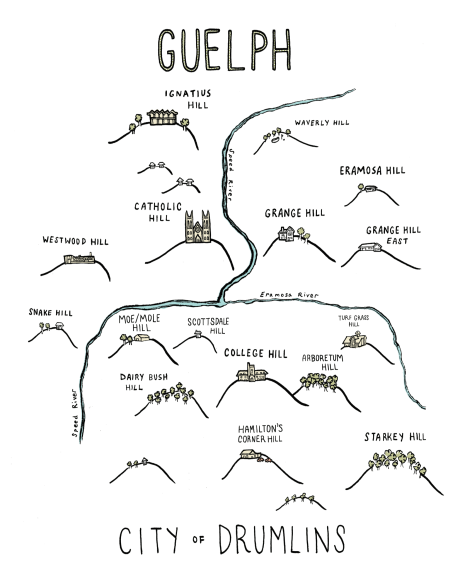
Exciting news, readers!
Your Urban Geographer is expanding his experience of Southern Ontario and setting up shop in Guelph.
Guelph is a lovely little city just down the road from Toronto (the road happens to be the 401…), and is the perfect environment to pursue a Masters in Landscape Architecture from the University of Guelph. That’s right, friends – this urban geographer is no longer just a passionate observer of the city – he’s going to be making city too!
I’ve had the pleasure of getting to know this city slowly from afar, visiting for music festivals or to just spend time with friends. From afar, I’ve developed a few ideas and speculations about Guelph that I’d like to note before getting into the nitty gritty of its culture, ecology, history, geology etc.
Guelph has strong connections to its agricultural hinterland. Since its inception, the city has identified as an agricultural centre, and the University of Guelph started as the University of Toronto’s agricultural college, splintering as an independent institution only 50 years ago.
You can take a city bus to the countryside in Guelph. You can bike to farms in under 10 minutes. Guelph has resisted the sprawl typical of Southern Ontario cities, and has only recently given in to density, with its residential suburbs in its south end. Even though it was designated by the Ontario government as a growth centre which lead to the south end’s suburbs, the sprawl is twice as dense as typical Ontario developments. The city also fought passionately against a Wal-Mart opening up – which it inevitably did, but the battle is evident of a populace who understands the limits of growth, the need for density and the value of preserving a distinction between town and country.
Guelph’s nickname is the Royal City – but I think it should be the Rural City – a city that has, not always perfectly – found the balance between urban and rural – two human settlement patterns that depend on each other anyway.
Guelph is a 10 minute drive north of the 401, and I think this separation has been critical to its positive development — not awash with a sea of cars coming through the 401, the “inconvenience” of the 8 km between Guelph and the highway has made all the difference.
Guelph is vital – its a small Ontario city where people are interested in each other. Its ecology is alive – built at the confluence of the Eromosa and Speed Rivers – tributaries of the Grand River which run into Lake Eerie. The rivers move fast and the air is clean and refreshed by its moving waters.
My favourite view of Guelph so far is from the high lands south of the Eramosa River, looking north toward the city centre. It is a verdant, lush city, humid in the late summer heat. But instead of the ubiquitous glass condo tower, the only thing that rises from the green is the Basilica of Our Lady of the Immaculate – a grand cathedral that centres Guelph as would a church in a small city in France or Germany.
I’m interested in my relationship to Toronto as I study in Guelph. I will go back often – as your Toronto-based Urban Geographer I naturally have lots to do there with forthcoming projects and articles.
I am excited to avoid driving to Toronto as much as possible. I have romantic notions of taking the train — a GO line runs to Guelph, but for now its a commuter train that only leaves twice in the morning, coming back twice in the evening. It stops just short of Guelph in in Aberfoyle at the other times of the day due to conflicts with the CN/CP schedule, the industrial owner of the stretch of track. This short-stopped service is holding Guelph back from the urban energy of Toronto and the southern Ontario mega region. Maybe this is a good thing.
If not the train, the GO bus does excellent service between downtown Guelph and Union Station in Toronto, or between the University of Guelph and York University. With the pending York subway extension, this might be a pretty good option!
I am excited to feel Toronto as an insider/outsider – to understand the city in a regional context. To feel the dynamism of its urban energy as something I’m not used to. I wonder what details I’ll pick up – what difference I will notice. How it will feel to enter the city from the west.
I look forward to updating you on my insights of Southern Ontario and its many cities. I hope you enjoy this slightly new perspective as your Urban Geographer.





 Guelph is a small city with a small bus system.
Guelph is a small city with a small bus system.







